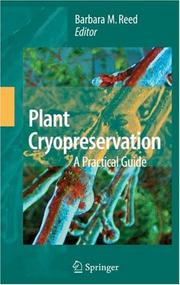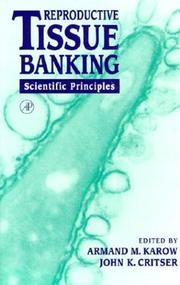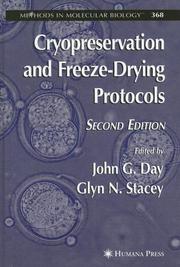| Listing 1 - 10 of 11 | << page >> |
Sort by
|
Book
ISBN: 9535143263 9535103024 Year: 2012 Publisher: IntechOpen
Abstract | Keywords | Export | Availability | Bookmark
 Loading...
Loading...Choose an application
- Reference Manager
- EndNote
- RefWorks (Direct export to RefWorks)
Almost a decade has passed since the last textbook on the science of cryobiology, Life in the Frozen State, was published. Recently, there have been some serious tectonic shifts in cryobiology which were perhaps not seen on the surface but will have a profound effect on both the future of cryobiology and the development of new cryopreservation methods. We feel that it is time to revise the previous paradigms and dogmas, discuss the conceptually new cryobiological ideas, and introduce the recently emerged practical protocols for cryopreservation. The present books, ""Current Frontiers in Cryobiology"" and ""Current Frontiers in Cryopreservation"" will serve the purpose. This is a global effort by scientists from 27 countries from all continents and we hope it will be interesting to a wide audience.
Cryopreservation of organs, tissues, etc. --- Cryoconservation of organs, tissues, etc. --- Cryogenic preservation of organs, tissues, etc. --- Low temperature preservation of organs, tissues, etc. --- Preservation of organs, tissues, etc. --- Cryobiology --- Cryonics --- Life Sciences --- Plant Biology --- Agricultural and Biological Sciences
Book
ISBN: 1626184755 9781626184756 9781626184749 1626184747 Year: 2013 Publisher: New York
Abstract | Keywords | Export | Availability | Bookmark
 Loading...
Loading...Choose an application
- Reference Manager
- EndNote
- RefWorks (Direct export to RefWorks)
Cultures (Biology) --- Cryopreservation of organs, tissues, etc. --- Plant cells and tissues --- Cryoconservation of organs, tissues, etc. --- Cryogenic preservation of organs, tissues, etc. --- Low temperature preservation of organs, tissues, etc. --- Preservation of organs, tissues, etc. --- Cryobiology --- Cryonics --- Cryopreservation.
Book
ISBN: 9535127802 9535127799 9535141430 Year: 2016 Publisher: IntechOpen
Abstract | Keywords | Export | Availability | Bookmark
 Loading...
Loading...Choose an application
- Reference Manager
- EndNote
- RefWorks (Direct export to RefWorks)
Since accidentally discovering the ability of glycerol on protecting cells from freezing damage, many researchers have been pursuing to develop cryopreservation methods of a very wide range of cells and some tissues, and these have found widespread applications in biology and medicine. From the point of view of living organisms, cryopreservation is a useful tool for ex situ conservation of genetic resources together with its contribution on conservation of their biodiversity. Cryopreservation in Eukaryotes includes totally 12 chapters, which have been written by the expert researchers in the field. The chapters are a comprehensive collection of the most frequently used methods for eukaryotes. With this book, every researcher will better understand the principles, background, and current status of cryopreservation in particular organisms.
Cryopreservation of organs, tissues, etc. --- Eukaryotic cells. --- Methodology. --- Eucaryotic cells --- Cells --- Protista --- Cryoconservation of organs, tissues, etc. --- Cryogenic preservation of organs, tissues, etc. --- Low temperature preservation of organs, tissues, etc. --- Preservation of organs, tissues, etc. --- Cryobiology --- Cryonics --- Life Sciences --- Microbiology --- Genetics and Molecular Biology --- Cytology --- Biochemistry
Book
ISBN: 3319785982 3319785990 Year: 2018 Publisher: Cham : Springer International Publishing : Imprint: Palgrave Pivot,
Abstract | Keywords | Export | Availability | Bookmark
 Loading...
Loading...Choose an application
- Reference Manager
- EndNote
- RefWorks (Direct export to RefWorks)
Cryonics—also known as cryopreservation or cryosuspension—is the preservation of legally dead individuals at ultra-low temperatures. Those who undergo this procedure hope that future technology will not only succeed in reviving them, but also cure them of the condition that led to their demise. In this sense, some hope that cryopreservation will allow people to continue living indefinitely. This book discusses the moral concerns of cryonics, both as a medical procedure and as an intermediate step toward life extension. In particular, Minerva analyses the moral issues surrounding cryonics-related techniques (including the hypothetical cryosuspension of fetuses as an alternative to abortion) by focusing on how they might impact the individuals who undergo cryosuspension, as well as society at large. .
Cryonics. --- Cryogenic interment --- Freezing of human bodies --- Human cold storage --- Burial --- Cryopreservation of organs, tissues, etc. --- Immortalism --- Resuscitation --- Technology—Sociological aspects. --- Bioethics. --- Physical anthropology. --- Science and Technology Studies. --- Biological and Physical Anthropology. --- Biological anthropology --- Somatology --- Anthropology --- Human biology --- Biology --- Biomedical ethics --- Life sciences --- Life sciences ethics --- Science --- Moral and ethical aspects
Book
ISBN: 026233870X 9780262338691 0262338696 9780262338707 9780262035859 0262035855 Year: 2017 Publisher: Cambridge, Massachusetts : The MIT Press,
Abstract | Keywords | Export | Availability | Bookmark
 Loading...
Loading...Choose an application
- Reference Manager
- EndNote
- RefWorks (Direct export to RefWorks)
The social, political, and cultural consequences of attempts to cheat death by freezing life.
Cryopreservation of organs, tissues, etc. --- Death --- Methods. --- Political aspects. --- Psychological aspects. --- SCIENCE, TECHNOLOGY & SOCIETY/General --- Cryoconservation of organs, tissues, etc. --- Cryogenic preservation of organs, tissues, etc. --- Low temperature preservation of organs, tissues, etc. --- Preservation of organs, tissues, etc. --- Cryobiology --- Cryonics --- Psychology

ISBN: 1281108286 9786611108281 0387722769 0387722750 1441924728 Year: 2008 Publisher: New York : Springer,
Abstract | Keywords | Export | Availability | Bookmark
 Loading...
Loading...Choose an application
- Reference Manager
- EndNote
- RefWorks (Direct export to RefWorks)
Plant Cryopreservation: A Practical Guide is a unique resource for plant scientists in many fields. This compilation provides over 100 ready-to-use protocols for plant types from algae and bryophytes to a range of flowering plants. It includes techniques for diverse plant parts such as dormant buds, pollen, and apical meristems, and for cell types such as suspension and callus cultures. Five introductory chapters describe theoretical principles, practical aspects of long-term cryopreserved storage, and details of the main cryopreservation techniques. The remaining 14 chapters are separated by plant type. Each chapter briefly reviews the literature and includes ready-to-use protocols designed for easy transfer into the lab and adaptation to new species.
Plant cells and tissues --- Germplasm resources, Plant --- Cryopreservation of organs, tissues, etc. --- Cryopreservation. --- Cryoconservation of organs, tissues, etc. --- Cryogenic preservation of organs, tissues, etc. --- Low temperature preservation of organs, tissues, etc. --- Preservation of organs, tissues, etc. --- Cryobiology --- Cryonics --- Agriculture. --- Plant genetics. --- Botany. --- Plant Genetics and Genomics. --- Plant Sciences. --- Botanical science --- Phytobiology --- Phytography --- Phytology --- Plant biology --- Plant science --- Biology --- Natural history --- Plants --- Genetics --- Farming --- Husbandry --- Industrial arts --- Life sciences --- Food supply --- Land use, Rural --- Plant science. --- Floristic botany

ISBN: 9780123997708 0123997704 9786611033125 128103312X 0080540546 9780080540542 Year: 1997 Publisher: San Diego : Academic Press,
Abstract | Keywords | Export | Availability | Bookmark
 Loading...
Loading...Choose an application
- Reference Manager
- EndNote
- RefWorks (Direct export to RefWorks)
Reproductive technologies to assist in both human conception and animal breeding are increasingly in demand. These technologies, along with the advent of tissue engineering, have propelled the challenges of tissue collection, preservation, and banking to the research forefront. Using examples drawn from reproductive technologies, Reproductive Tissue Banking presents the scientific principles underlying tissue banking. These examples serve as models for the technology of banking other living tissues, including blood, bone marrow, cornea, and skin.
Semen Preservation. --- Oocytes --- Embryo Transfer. --- Ovary --- Cryopreservation. --- Human reproductive technology. --- Sperm banks --- Cryopreservation of organs, tissues, etc. --- Embryo transplantation --- Procréation médicalement assistée --- Banques de sperme --- Cryoconservation des organes, tissus, etc. --- Embryons --- transplantation. --- Transplantation --- Sperm banks. --- Embryo transplantation. --- Embryo transfer --- Transfer of embryo --- Reproductive technology --- Transplantation of organs, tissues, etc. --- Cryoconservation of organs, tissues, etc. --- Cryogenic preservation of organs, tissues, etc. --- Low temperature preservation of organs, tissues, etc. --- Preservation of organs, tissues, etc. --- Cryobiology --- Cryonics --- Semen banks --- Germplasm resources, Animal --- Tissue banks --- Assisted conception --- Assisted human reproduction --- Assisted human reproductive technology --- Conception --- Human assisted reproduction --- Human assisted reproductive technology --- Human reproduction --- Medical technology --- Technological innovations --- Oocytes - transplantation. --- Ovary - transplantation.
Book
ISBN: 3540887849 364210021X 9786611955366 1281955361 3540887857 Year: 2009 Publisher: Berlin : Springer,
Abstract | Keywords | Export | Availability | Bookmark
 Loading...
Loading...Choose an application
- Reference Manager
- EndNote
- RefWorks (Direct export to RefWorks)
The book gives a summary of the state-of-the-art of cryobiology and its applications. The accent is on the underlying physical phenomena, which are common in such opposite applications as cryosurgery and cryoconservation, and the corresponding mathematical models, including numerical ones. The treatment of some more special issues is moved to the appendices. The glossary contains definitions and explanations of the major entities. All the topics considered are well referenced. The book is useful to both biologists and physicits of different level including practioners and graduate students.
Biomedical Engineering. --- Life sciences. --- Cryobiology --- Protective Agents --- Histocytological Preparation Techniques --- Ablation Techniques --- Preservation, Biological --- Phase Transition --- Investigative Techniques --- Cold Temperature --- Temperature --- Cytological Techniques --- Physiological Effects of Drugs --- Analytical, Diagnostic and Therapeutic Techniques and Equipment --- Physicochemical Processes --- Specimen Handling --- Physical Processes --- Histological Techniques --- Surgical Procedures, Operative --- Specialty Uses of Chemicals --- Physical Phenomena --- Chemical Actions and Uses --- Laboratory Techniques and Procedures --- Thermodynamics --- Clinical Laboratory Techniques --- Pharmacologic Actions --- Chemical Processes --- Physicochemical Phenomena --- Chemical Phenomena --- Phenomena and Processes --- Diagnosis --- Chemicals and Drugs --- Freezing --- Cryopreservation --- Tissue Preservation --- Models, Theoretical --- Cryosurgery --- Cryoprotective Agents --- Methods --- Biology --- Health & Biological Sciences --- Biology - General --- Biophysics --- Mathematical models --- Cryobiology. --- Cryopreservation of organs, tissues, etc. --- Low temperature biology --- Cryoconservation of organs, tissues, etc. --- Cryogenic preservation of organs, tissues, etc. --- Low temperature preservation of organs, tissues, etc. --- Physics. --- Biophysics. --- Biological physics. --- Biophysics and Biological Physics. --- Life Sciences, general. --- Preservation of organs, tissues, etc. --- Cryonics --- Cold --- Low temperatures --- Biological and Medical Physics, Biophysics. --- Biosciences --- Sciences, Life --- Science --- Biological physics --- Medical sciences --- Physics

ISBN: 1588293777 9786610971701 1280971703 1597453625 Year: 2007 Publisher: Totowa, NJ : Humana Press : Imprint: Humana,
Abstract | Keywords | Export | Availability | Bookmark
 Loading...
Loading...Choose an application
- Reference Manager
- EndNote
- RefWorks (Direct export to RefWorks)
Cryopreservation and Freeze-Drying Protocols: Second Edition is a compilation of robust, reproducible techniques for the conservation of a wide range of biological materials. This widely expanded second edition includes novel approaches and protocols for biological materials that were not preservable when the first edition was published in 1995. This volume begins with a discussion of long term ex situ conservation of biological resources, the role of biological resource centers, and fundamental principles of freeze-drying and cryopreservation. Each chapter focuses on the preservation of specific biological materials, including proteins, mircroorganisms, cell lines, and multicellular structures. Detailed descriptions of materials required and stepwise protocols are presented for each preservation method, along with explanatory notes that highlight key technical issues. The troubleshooting and background notes provided for each protocol enhance this practical and reliable resource for the conservation and sustainable use of biological resources.
Cryopreservation of organs, tissues, etc. --- Freeze-drying --- Lyophilization --- Cryoconservation of organs, tissues, etc. --- Cryogenic preservation of organs, tissues, etc. --- Low temperature preservation of organs, tissues, etc. --- Methodology. --- Life sciences. --- Biochemistry. --- Cell biology. --- Plant physiology. --- Animal physiology. --- Biophysics. --- Biological physics. --- Biomaterials. --- Life Sciences. --- Biochemistry, general. --- Cell Biology. --- Biophysics and Biological Physics. --- Animal Physiology. --- Plant Physiology. --- Cryobiology --- Drying apparatus --- Refrigeration and refrigerating machinery --- Sublimation (Chemistry) --- Preservation of organs, tissues, etc. --- Cryonics --- Cytology. --- Biological and Medical Physics, Biophysics. --- Botany --- Plants --- Physiology --- Animal physiology --- Animals --- Biology --- Anatomy --- Biocompatible materials --- Biomaterials --- Medical materials --- Medicine --- Biomedical engineering --- Materials --- Biocompatibility --- Prosthesis --- Cell biology --- Cellular biology --- Cells --- Cytologists --- Biological chemistry --- Chemical composition of organisms --- Organisms --- Physiological chemistry --- Chemistry --- Medical sciences --- Composition --- Bioartificial materials --- Hemocompatible materials --- Biomaterials (Biomedical materials)
Book
ISBN: 981154025X 9811540241 Year: 2020 Publisher: Singapore : Springer Singapore : Imprint: Springer,
Abstract | Keywords | Export | Availability | Bookmark
 Loading...
Loading...Choose an application
- Reference Manager
- EndNote
- RefWorks (Direct export to RefWorks)
Understanding the reproductive physiology and endocrinology of fishes is essential for captive maturation and seed production in the field of aquaculture. Studying the spermatology of fishes is a comparatively new focus in aquaculture, which has emerged as an important area of fish research over the past two decades. In this regard, the cryopreservation of fish gametes is a crucial aspect. Moreover, energetics studies of gametes have become essential, considering the loss of vigour in the spermatozoa after cryopreservation. The latest development in this context is the cryopreservation of spermatogonial stem cell, which is also covered in the book, along with detailed information on embryo cryopreservation in fishes and crustaceans. The role of cryopreservation in conservation programmes is another important aspect, one that will especially interest biologists. This book addresses central issues in fish gamete cryopreservation and breeding, while also reviewing the history of cryopreservation. Its most unique feature is the breadth of its coverage, from basic information on reproduction in fishes, to such advanced topics as embryo cryopreservation. Chiefly intended as a handy troubleshooting guide, the book represents a valuable resource for research students in related fields.
Cryopreservation of organs, tissues, etc. --- Cryoconservation of organs, tissues, etc. --- Cryogenic preservation of organs, tissues, etc. --- Low temperature preservation of organs, tissues, etc. --- Preservation of organs, tissues, etc. --- Cryobiology --- Cryonics --- Wildlife. --- Fish. --- Animal physiology. --- Biochemistry. --- Conservation biology. --- Ecology . --- Embryology. --- Fish & Wildlife Biology & Management. --- Animal Physiology. --- Animal Biochemistry. --- Conservation Biology/Ecology. --- Animal embryology --- Animals --- Development, Embryological --- Development, Embryonic --- Development, Zygotic --- Embryogenesis --- Embryogeny --- Embryological development --- Embryonic development --- Zoology --- Zygote development --- Zygotes --- Zygotic development --- Zygotic embryogenesis --- Developmental biology --- Morphology (Animals) --- Embryos --- Reproduction --- Balance of nature --- Biology --- Bionomics --- Ecological processes --- Ecological science --- Ecological sciences --- Environment --- Environmental biology --- Oecology --- Environmental sciences --- Population biology --- Ecology --- Nature conservation --- Biological chemistry --- Chemical composition of organisms --- Organisms --- Physiological chemistry --- Chemistry --- Medical sciences --- Animal physiology --- Anatomy --- Fish --- Pisces --- Aquatic animals --- Vertebrates --- Fisheries --- Fishing --- Ichthyology --- Embryology --- Development --- Composition --- Physiology --- Aqüicultura --- Fisiologia animal --- Reproducció --- Peixos --- Fauna aquàtica --- Vertebrats --- Àgnats --- Condrictis --- Osteïctis --- Peixos d'aigua dolça --- Peixos d'aquari --- Peixos exòtics --- Peixos marins --- Peixos plans --- Piscicultura --- Ictiologia --- Indústria pesquera --- Peix --- Pesca --- Reproducció animal --- Reproducció sexual --- Biologia --- Vida (Biologia) --- Cèl·lules --- Embaràs --- Fecunditat --- Fetus --- Generació espontània --- Ovulació --- Part --- Partenogènesi --- Reproducció asexual --- Reproducció assistida --- Reproducció de les plantes --- Reproducció humana --- Aparell genital --- Embriologia --- Sexualitat --- Fisiologia --- Producció animal --- Agricultura --- Aqüicultura marina
| Listing 1 - 10 of 11 | << page >> |
Sort by
|

 Search
Search Feedback
Feedback About UniCat
About UniCat  Help
Help News
News